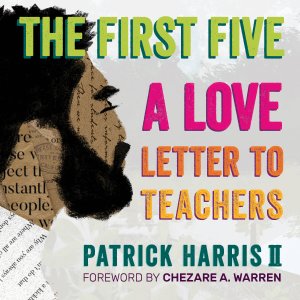Reframing How to Think About Change in Public Education
New teachers often become disillusioned because of their inability to effect change in the education system. A new book, The First Five, has some helpful advice.
Your content has been saved!
Go to My Saved Content.To sustain myself in the profession, I had to process my own beliefs about change. I know I’m not alone with having an unspeakable frustration with the ways our country and systems leave the needs of children and teachers out to dry. I have a witness out there? Our frustration with the system is one of the biggest reasons why teachers quit and a part of this is a misunderstanding of how change happens. I want you here for the long haul. So it can be helpful to examine what happened through the lens of emergent strategy.
Informed by adrienne maree brown’s core principles, here are my beliefs about change in schools:
- Effective change is slow and small.
- Change is about relationships, not just about strategy.
- Change reveals our interconnectedness.
- Systems of power are upheld by people.
- Change is constant.
Effective Change Is Slow and Small
I label myself a fantast. This means I am a dreamer. I ask myself big questions that I don’t have the answers to. I think of big plans that some people raise their eyebrows in “I don’t know about all that” energy. My solutions are usually just as big as my dreams and my questions.

Just burn it all down and start over. I mean, that’s the easiest way right? But I have learned through failure, through conversations, and through relationships that dreaming big means thinking small. Brown teaches us that small change is still a reflection of the larger system. As cheesy as it sounds, planting the seed still matters. So, that risk you take in your classroom still counts. Developing a plan even though it does not get adopted still matters. Organizing a protest and a list of demands still counts. Scheduling a meeting to build a connection still counts.
Change, particularly in schools, is slow and it starts small. This is because everyone wants buy-in. And in theory this is a good thing. We cannot make change without having us all onboard. (Beware of those with privilege and power who purposefully block change.) When we start small, this can still lead to big change. You may not be the one who waters the seed or feeds it or ensures it gets sunlight on cloudy days. But, roses, even in concrete, don’t grow without seeds.
Change Is About Relationships, not Just About Strategy
This is layered. From my experience, I have learned that making change in school is hardly ever about how good your plan is. You can spend all day and all night dotting your i’s and crossing your t’s. Include the latest research. But if you do not have the relationships with the people who the change will impact, it is useless. Relationships in education are measured by trust. It took me a long time to learn this. I used to think my administrators, colleagues, students had to “like” me.
You know what I mean? Being liked is a temporary feeling and it is something you hardly have any control over. People’s personal roller coasters will impact whether they like you today and whether that changes tomorrow. But trust is more long-lasting. Trust is measurable. Trust is something you can plan for. You feel me? And so, while I may not always like my administrators, I have to figure out if I can trust them to make the best decisions for the students and educators in the building. And they have to know they can trust you.
I know ego, perfectionism, and pressure can be in the way. Emergent strategy pushed me to think about animals and plants and how they trust without debate. I saw an Instagram reel recently that showcased a colony of bees making a ball around an imposter queen bee. She had to be destroyed. Without question, argument, or debate these bees worked together to create a ball around this sus bee. They buzzed in harmony creating a pocket of heat. This heat exploded the bee into bits and then the colony of bees went back to protecting their actual queen. Nothing would stop them from protecting their ecosystem.
As humans, particularly adults, we do not work well together unless we have a certain level of trust. (This is what we mean when we say buy-in.) And rightfully so. History has taught us to not trust each other because humans create unnecessary harm every day. Whether physical, emotional, or mental violence, institutional violence or educational violence, our flawed nature makes room for distrust. But if we are moving towards change, trust is a very necessary component. This requires intentionality and risk-taking. Self-awareness and evaluation. We must be intentional about building trust with our students and their families. And our colleagues and administrators.
We must respect that this trust takes time, depending on the person. But that’s OK. Change is small and slow. Trust also requires risk-taking. Sometimes we are in the building stages of developing a relationship or a relationship is rocky. We can still choose to trust one another. In some cases, we have to choose to trust one another. Give the plan a chance, even if you think it may fail. Allow colleagues and administrators to voice their opinions; it may push the conversation forward. If we don’t trust people, we can’t build relationships. And without relationships, change is impossible.
This also means knowing and engaging with opposing views. Now let me be clear here. Our country glorifies extremists. I’m not talking about them: white supremacists, Karens, obstructionists. Not them. I’m talking about people who have a different experience than you and simply disagree with your ideas (not your humanity). In grad school, I learned that algorithms are designed to show you ads and posts you are likely to engage with. And studies show that you are likely to engage with posts that affirm your own beliefs.
Thus, as much time as we spend on our phones giving our opinions, it is less likely that we are actually having healthy dialogue with people who disagree with us. I choose to believe that we all have the same end goal in education: to prepare healthy and whole young people to thrive in the world. But we all have different ways of getting there. It is our duty and responsibility to affirm our shared humanity and give space to have dialogue.
Change Reveals Our Interconnectedness
Change is often coupled with fear. How will this impact me? The more we discuss change in schools, the more we reveal how connected we all are. What we do as teachers impacts our administrators. The activities we plan impact custodial staff. Deciding to renovate a building impacts the surrounding community. The laws and policies created by local school boards impact teachers. And all of the ways we make decisions in education impact young people. Period.
An easy way to think about interconnectedness is to consider the way the building shifts when someone is absent. You know that feeling when you come in and the hallway is quieter than normal. Or when you go down to pick up your class for the start of the day and you see a substitute. “They’re not here today?” You may acknowledge a shift in your energy. This is showing how interconnected we all are.
So when we are considering the ways we can make change, we have to consider how everyone is impacted by that change. Remember, we want to make system change because it’s long-lasting. And if we are changing systems, then we must know that everyone is impacted by this. As we are devising our plans, it is healthy for us to acknowledge the ways our interconnectedness will be impacted by change.
With this interconnectedness, we should see the value of interdependence and shared leadership.
Excerpt from The First Five: A Love Letter to Teachers by Patrick Harris II. Copyright (c) 2022 by Patrick Harris II. Published by Heinemann, Portsmouth, NH. Reprinted by permission of the Publisher.
